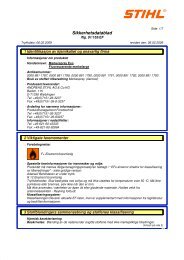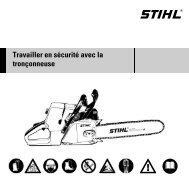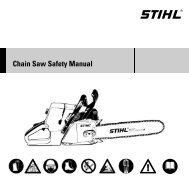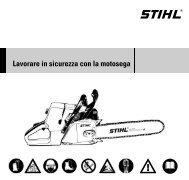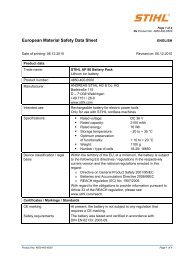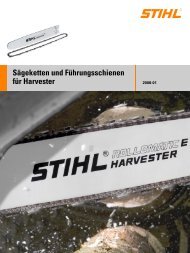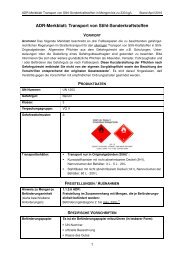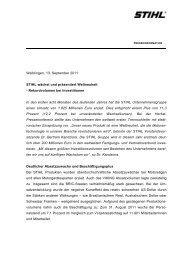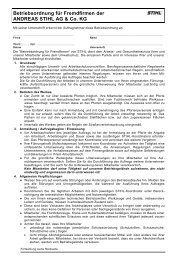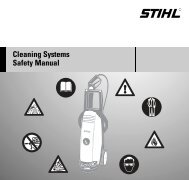You also want an ePaper? Increase the reach of your titles
YUMPU automatically turns print PDFs into web optimized ePapers that Google loves.
<strong>Hedge</strong> <strong>Trimmer</strong> <strong>Safety</strong> <strong>Manual</strong><br />
{
Original Instruction <strong>Manual</strong><br />
Printed on chlorine-free paper<br />
Printing inks contain vegetable oils, paper can be recycled.<br />
© ANDREAS STIHL AG & Co. KG, 2009<br />
0457-189-0121. M0.K09.xxx.<br />
0000000557_001_GB<br />
Contents<br />
<strong>Safety</strong> Precautions and Working<br />
Techniques 2<br />
Using the Unit 7<br />
Maintenance and Care 9<br />
Main Parts 11<br />
{<br />
<strong>Hedge</strong> <strong>Trimmer</strong> <strong>Safety</strong> <strong>Manual</strong><br />
English<br />
This manual contains the safety<br />
precautions and recommended cutting<br />
techniques outlined in the instruction<br />
manuals for STIHL hedge trimmers.<br />
The chapters on "Using the Unit" and<br />
"Parts and Controls" show model HS 81<br />
as an example.<br />
Other hedge trimmer models may have<br />
different parts and controls.<br />
This manual contains references to<br />
various chapters in the model-specific<br />
instruction manuals.<br />
You should therefore always refer to the<br />
instruction manual of your particular<br />
hedge trimmer model.<br />
Please contact your STIHL dealer if you<br />
have any further questions after reading<br />
this manual.<br />
1
English<br />
<strong>Safety</strong> Precautions and<br />
Working Techniques<br />
Observe all application local safety<br />
regulations, standards and ordinances.<br />
If you have not used this type of power<br />
tool before: Have your dealer or other<br />
experienced user show you how to<br />
operate your power tool or attend a<br />
special course in power tool operation.<br />
Minors should never be allowed to use a<br />
power tool.<br />
Bystanders, especially children, and<br />
animals should not be allowed in the<br />
area where a power tool is in use.<br />
When the power tool is not in use, shut it<br />
off so that it does not endanger others.<br />
Secure it against unauthorized use.<br />
The user is responsible for avoiding<br />
injury to third parties or damage to their<br />
property.<br />
2<br />
Special safety precautions<br />
must be observed<br />
when working with this<br />
power tool because it has<br />
very sharp, high-speed<br />
cutting blades.<br />
It is important you read<br />
and understand the<br />
instruction manual before<br />
using your unit for the<br />
first time and keep the<br />
manual in a safe place for<br />
future reference. Nonobservance<br />
of the safety<br />
precautions may result in<br />
serious or even fatal<br />
injury.<br />
Do not lend or rent your power tool<br />
without the instruction manual. Be sure<br />
that anyone using it understands the<br />
information contained in this manual.<br />
The use of noise emitting power tools<br />
may be restricted to certain times by<br />
national or local regulations.<br />
To operate the power tool you must be<br />
rested, in good physical condition and<br />
mental health.<br />
If you have any condition that might be<br />
aggravated by strenuous work, check<br />
with your doctor before operating a<br />
power tool.<br />
Persons with pacemakers only: The<br />
ignition system of your power tool<br />
produces an electromagnetic field of a<br />
very low intensity. This field may<br />
interfere with some pacemakers. To<br />
reduce health risks, STIHL recommends<br />
that persons with pacemakers consult<br />
their physician and the pacemaker<br />
manufacturer before operating this tool.<br />
Do not operate the power tool if you are<br />
under the influence of any substance<br />
(drugs, alcohol) which might impair<br />
visions, dexterity or judgment.<br />
Use your hedge trimmer only for cutting<br />
hedges, shrubs, scrub and similar<br />
materials.<br />
It must not be used for any other<br />
purpose because of the increased risk of<br />
accidents and damage to the machine.<br />
Never attempt to modify your power tool<br />
in any way since this may result in<br />
accidents or damage to the machine.<br />
Only use parts and accessories that are<br />
explicity approved for this power tool by<br />
STIHL or are technically identical. If you<br />
have any questions in this respect,<br />
consult a servicing dealer. Use only high<br />
quality parts and accessories in order to<br />
avoid the risk of accidents and damage<br />
to the machine.<br />
STIHL recommends the use of genuine<br />
STIHL replacement parts. They are<br />
specifically designed to match your<br />
model and meet your performance<br />
requirements.<br />
Never attempt to modify your power tool<br />
in any way since this will increase the<br />
risk of personal injury. STIHL excludes<br />
all liability for personal injury and<br />
damage to property caused while using<br />
unauthorized attachments.<br />
Do not use a pressure washer to clean<br />
the power tool. The solid jet of water<br />
may damage parts of the tool.<br />
Clothing and Equipment<br />
Wear proper protective clothing and<br />
equipment.<br />
Clothing must be sturdy<br />
but allow complete freedom<br />
of movement. Wear<br />
snug-fitting clothing, an<br />
overall and jacket combination,<br />
do not wear a<br />
work coat.<br />
Avoid clothing that could get caught on<br />
branches or brush or moving parts of the<br />
machine. Do not wear a scarf, necktie or<br />
jewelry. Tie up and confine long hair<br />
(e.g. with a hair net, cap, hard hat, etc.).<br />
Wear sturdy shoes with non-slip soles.<br />
<strong>Hedge</strong> <strong>Trimmer</strong> <strong>Safety</strong> <strong>Manual</strong>
STIHL offers a comprehensive range of<br />
personal protective clothing and<br />
equipment.<br />
Transporting the Power Tool<br />
Always turn off the engine.<br />
Always fit the blade guard (scabbard)<br />
before carrying your hedge trimmer<br />
short distances.<br />
Carry the power tool by the handle –<br />
cutting blades behind you. Avoid<br />
touching hot parts of the machine,<br />
especially the muffler and gear housing<br />
– you could suffer serious burns.<br />
Transporting in a vehicle: Properly<br />
secure your power tool to prevent<br />
turnover, fuel spillage and damage.<br />
Fueling<br />
Wear safety glasses and<br />
hearing protection, e.g.<br />
earplugs or ear muffs.<br />
Wear heavy-duty gloves.<br />
Gasoline is an<br />
extremely flammable<br />
fuel. Keep clear of naked<br />
flames. Do not spill any<br />
fuel – do not smoke.<br />
Always shut off the engine before<br />
refueling.<br />
<strong>Hedge</strong> <strong>Trimmer</strong> <strong>Safety</strong> <strong>Manual</strong><br />
Do not fuel a hot engine – fuel may spill<br />
and cause a fire.<br />
Open the fuel cap carefully to allow any<br />
pressure build-up in the tank to release<br />
slowly and avoid fuel spillage.<br />
Fuel your power tool only in wellventilated<br />
areas. If you spill fuel, wipe<br />
the machine immediately – if fuel gets on<br />
your clothing, change immediately.<br />
Your power tool comes standard with<br />
either a screw-type or bayonet-type fuel<br />
cap.<br />
This reduces the risk of unit vibrations<br />
causing the fuel cap to loosen or come<br />
off and spill quantities of fuel.<br />
To reduce the risk of serious of fatal<br />
burn injuries, check for fuel leakage. If<br />
fuel leakage is found, do not start or run<br />
the engine until leak is fixed.<br />
Before Starting<br />
After fueling, tighten<br />
down the screw-type fuel<br />
cap as securely as<br />
possible.<br />
Insert the fuel cap with<br />
hinged grip (bayonet-type<br />
cap) correctly in the<br />
opening, turn it clockwise<br />
as far as stop and fold the<br />
grip down.<br />
Check that your power tool is properly<br />
assembled and in good condition – refer<br />
to appropriate chapters in the instruction<br />
manual.<br />
English<br />
– Engage the blade lock (if fitted).<br />
– Slide control / stop switch must<br />
move easily to STOP or 0<br />
– Smooth action of throttle trigger<br />
interlock and throttle trigger – the<br />
throttle trigger must return<br />
automatically to the idle position.<br />
– Check that the spark plug boot is<br />
secure – a loose boot may cause<br />
arcing that could ignite combustible<br />
fumes and cause a fire.<br />
– Cutting blades securely mounted<br />
and in good condition (clean, move<br />
freely, not warped), properly<br />
sharpened and thoroughly sprayed<br />
with STIHL resin solvent (lubricant).<br />
– Check cutter guard (if fitted) for<br />
damage.<br />
– Never attempt to modify the controls<br />
or the safety devices in any way.<br />
– Keep the handles dry and clean –<br />
free from oil and dirt – for safe<br />
control of the power tool.<br />
To reduce the risk of personal injury,<br />
do not operate your power tool if it is<br />
damaged or not properly assembled.<br />
Starting the Engine<br />
Start the engine at least 3 meters from<br />
the fueling spot, outdoors only.<br />
Place the unit on firm ground in an open<br />
area. Make sure you have good balance<br />
and secure footing. Hold the unit<br />
securely. The cutting blades must be<br />
clear of the ground and all other<br />
obstructions because they may begin to<br />
run when the engine starts.<br />
3
English<br />
Your power tool is designed to be<br />
operated by one person only. Do not<br />
allow other persons in the work area –<br />
even when starting.<br />
To reduce the risk of injury, avoid<br />
contact with the cutting blades.<br />
Do not drop start the power tool – start<br />
the engine as described in the<br />
instruction manual.<br />
Note that the cutting blades continue to<br />
run for a short period after you let go of<br />
the throttle trigger (flywheel effect).<br />
Check idle speed setting: The cutting<br />
blades must not move when the engine<br />
is idling with the throttle trigger released.<br />
Holding and Controlling the Unit<br />
Always hold the unit firmly with both<br />
hands on the handles. Wrap your fingers<br />
and thumbs around the handles.<br />
Right-handers<br />
Right hand on the control handle and left<br />
hand on the front handle.<br />
4<br />
Left-handers<br />
Left hand on the control handle and right<br />
hand on the front handle.<br />
Make sure you have firm and secure<br />
footing and hold the unit so that the<br />
cutting blades are always away from<br />
your body.<br />
During Operation<br />
In the event of impending danger or in<br />
an emergency, switch off the engine<br />
immediately by moving the slide control<br />
/ stop switch to 0 or STOP.<br />
Check that there are no bystanders in<br />
the general work area.<br />
Watch the cutting blades at all times –<br />
do not cut areas of the hedge that you<br />
cannot see.<br />
Be extremely careful when cutting tall<br />
hedges, check the other side of the<br />
hedge before starting work.<br />
Make sure the idle speed setting is<br />
correct. The cutting blades must not run<br />
when the engine is idling with the throttle<br />
trigger released.<br />
If the cutting blades still run, have your<br />
dealer check your machine and make<br />
proper adjustments or repairs. Check<br />
and correct the idle speed setting at<br />
regular intervals.<br />
Note that the cutting blades continue to<br />
run for a short period after you let go of<br />
the throttle trigger (flywheel effect).<br />
The gearbox becomes hot during<br />
operation. To reduce the risk of burn<br />
injury, do not touch the gear housing.<br />
Take special care in slippery conditions<br />
– damp, snow, ice, on slopes or uneven<br />
ground.<br />
Clear away fallen branches, scrub and<br />
cuttings.<br />
Watch out for obstacles: Roots, tree<br />
stumps or holes which could cause you<br />
to trip or stumble.<br />
Make sure you always have good<br />
balance and secure footing.<br />
When working at heights:<br />
– Always use a lift bucket<br />
– Never work on a ladder or in a tree<br />
– Never work on an insecure support<br />
– Never operate your unit with one<br />
hand<br />
Be particularly alert and cautious when<br />
wearing hearing protection because<br />
your ability to hear warnings (shouts,<br />
alarms, etc.) is restricted.<br />
To reduce the risk of accidents, take a<br />
break in good time to avoid tiredness or<br />
exhaustion.<br />
<strong>Hedge</strong> <strong>Trimmer</strong> <strong>Safety</strong> <strong>Manual</strong>
Work calmly and carefully – in daylight<br />
conditions and only when visibility is<br />
good. Stay alert so as not to endanger<br />
others.<br />
Your power tool produces<br />
toxic exhaust fumes as<br />
soon as the engine is<br />
running. These fumes<br />
may be colorless and<br />
odorless and contain<br />
unburned hydrocarbons<br />
and benzol. Never run<br />
the engine indoors or in<br />
poorly ventilated locations,<br />
even if your model<br />
is equipped with a catalytic<br />
converter.<br />
To reduce the risk of serious or fatal<br />
injury from breathing toxic fumes,<br />
ensure proper ventilation when working<br />
in trenches, hollows or other confined<br />
locations.<br />
To reduce the risk of accidents, stop<br />
work immediately in the event of<br />
nausea, headache, visual disturbances<br />
(e.g. reduced field of vision), problems<br />
with hearing, dizziness, deterioration in<br />
ability to concentrate. Apart from other<br />
possibilities, these symptoms may be<br />
caused by an excessively high<br />
concentration of exhaust gases in the<br />
work area.<br />
Operate your power tool so that it<br />
produces a minimum of noise and<br />
emissions – do not run the engine<br />
unnecessarily, accelerate the engine<br />
only for cutting.<br />
To reduce the risk of fire, do not smoke<br />
while operating or standing near your<br />
power tool. Note that combustible fuel<br />
vapor may escape from the fuel system.<br />
<strong>Hedge</strong> <strong>Trimmer</strong> <strong>Safety</strong> <strong>Manual</strong><br />
If your power tool is subjected to<br />
unusually high loads for which it was not<br />
designed (e.g. heavy impact or a fall),<br />
always check that it is in good condition<br />
before continuing work – see also<br />
"Before Starting". Check the fuel system<br />
in particular for leaks and make sure the<br />
safety devices are working properly. Do<br />
not continue operating your power tool if<br />
it is damaged. In case of doubt, have the<br />
machine checked by your servicing<br />
dealer.<br />
Do not operate your power tool with the<br />
starting throttle lock engaged – engine<br />
speed cannot be controlled in this<br />
position.<br />
Inspect the hedge and work area to<br />
avoid damaging the cutting blades:<br />
– Remove stones, rocks, pieces of<br />
metal and other solid objects.<br />
– When working close to the ground,<br />
make sure that no sand, grit or<br />
stones get between the blades.<br />
– Take particular care when cutting<br />
hedges next to or against wire<br />
fences.<br />
To avoid the risk of electrocution, do<br />
not touch electric power lines – never cut<br />
through electric power lines.<br />
Do not touch the cutting<br />
blades while the engine is<br />
running. If the cutting<br />
blades become jammed<br />
by thick branches or<br />
other obstructions, switch<br />
off the engine immediately<br />
before attempting to<br />
free the blades.<br />
English<br />
Opening the throttle while the blades are<br />
blocked increases the load and reduces<br />
engine speed. The clutch then slips<br />
continuously and this causes<br />
overheating and damage to important<br />
components (e.g. clutch, polymer<br />
housing components) – and this can<br />
increase the risk of injury from the<br />
blades moving while the engine is idling.<br />
If the hedge is very dusty or dirty, spray<br />
the blades with STIHL resin solvent from<br />
time to time during cutting. This helps<br />
reduce blade friction as well as the<br />
aggressive effects of sap and the buildup<br />
of dirt particles.<br />
The dust that occurs during operation<br />
may be harmful to health. If dust levels<br />
are very high, wear a suitable respirator.<br />
Before leaving the power tool<br />
unattended: Shut off the engine.<br />
Check the cutting blades at regular short<br />
intervals during operation or<br />
immediately if there is a noticeable<br />
change in cutting behavior:<br />
– To shut down the engine<br />
– Wait until the cutting blades have<br />
come to a complete standstill.<br />
– Check condition and tightness, look<br />
for cracks.<br />
– Check sharpness.<br />
To reduce the risk of fire, always clean<br />
plant residue, chips, leaves and excess<br />
lubricant off the engine and muffler.<br />
After Finishing Work<br />
Always clean dust and dirt off the<br />
machine – do not use any grease<br />
solvents for this purpose.<br />
5
English<br />
Spray the blades with STIHL resin<br />
solvent. Run the engine briefly so that<br />
the solvent is evenly distributed.<br />
Vibrations<br />
Prolonged use of the power tool may<br />
result in vibration-induced circulation<br />
problems in the hands ("white finger<br />
disease").<br />
No general recommendation can be<br />
given for the length of usage because it<br />
depends on several factors.<br />
The period of usage is prolonged by:<br />
– Hand protection (wearing warm<br />
gloves)<br />
– Work breaks<br />
The period of usage is shortened by:<br />
– Any personal tendency to suffer<br />
from poor circulation (symptoms:<br />
frequently cold fingers, tingling<br />
sensation)<br />
– Low outside temperatures<br />
– Amount of gripping force (holding<br />
the power tool tightly restricts<br />
circulation)<br />
Users who use the machine periodically<br />
or for long periods or users who<br />
repeatedly experience corresponding<br />
symptoms (e.g., tingling sensation in<br />
fingers), should undergo a medical<br />
examination.<br />
6<br />
Maintenance and Repairs<br />
Service the machine regularly. Do not<br />
attempt any maintenance or repair work<br />
not described in the instruction manual.<br />
Have all other work performed by a<br />
servicing dealer.<br />
STIHL recommends that you have<br />
servicing and repair work carried out<br />
exclusively by an authorized STIHL<br />
servicing dealer. STIHL dealers are<br />
regularly given the opportunity to attend<br />
training courses and are supplied with<br />
the necessary technical information.<br />
Only use high-quality replacement parts<br />
in order to avoid the risk of accidents<br />
and damage to the machine. If you have<br />
any questions in this respect, consult a<br />
servicing dealer.<br />
STIHL recommends the use of genuine<br />
STIHL replacement parts. They are<br />
specifically designed to match your<br />
model and meet your performance<br />
requirements.<br />
To reduce the risk of injury, always shut<br />
off the engine before carrying out any<br />
maintenance or repairs or cleaning the<br />
machine. – Exception: Carburetor and<br />
idle speed adjustments.<br />
Do not turn the engine over on the<br />
starter with the spark plug boot or spark<br />
plug removed unless the slide control /<br />
stop switch is on STOP or 0 since there<br />
is otherwise a risk of fire from<br />
uncontained sparking.<br />
To reduce the risk of fire, do not service<br />
or store your machine near open flames.<br />
Check the fuel filler cap for leaks at<br />
regular intervals.<br />
Use only a spark plug of the type<br />
approved by STIHL and make sure it is<br />
in good condition – see "Specifications".<br />
Inspect the ignition lead (insulation in<br />
good condition, secure connection).<br />
Check the condition of the muffler.<br />
To reduce the risk of fire and damage<br />
to hearing, do not operate your<br />
machine if the muffler is damaged or<br />
missing.<br />
Do not touch a hot muffler since burn<br />
injury will result.<br />
Vibration behavior is influenced by the<br />
condition of the AV elements – check the<br />
AV elements at regular intervals.<br />
<strong>Hedge</strong> <strong>Trimmer</strong> <strong>Safety</strong> <strong>Manual</strong>
Using the Unit<br />
HS 81 R<br />
The HS 81 R is designed for cutting<br />
hedges and shrubs with thicker stems<br />
and branches.<br />
HS 81 T<br />
The HS 81 T is designed for shaping<br />
and trimming hedges and shrubs with<br />
thinner branches.<br />
Use the HS 81 R hedge trimmer for<br />
cutting hedges with thicker branches.<br />
Cutting Season<br />
Observe country-specific or municipal<br />
rules and regulations for cutting hedges.<br />
<strong>Hedge</strong> <strong>Trimmer</strong> <strong>Safety</strong> <strong>Manual</strong><br />
Do not use your power tool during other<br />
people's rest periods.<br />
Cutting Sequence<br />
Use lopping shears or a chain saw to cut<br />
out thick branches first.<br />
Cut both sides of the hedge first, then<br />
the top.<br />
Disposal<br />
Do not throw cuttings into the garbage<br />
can – they can be composted!<br />
Cutting Techniques<br />
Vertical cut<br />
English<br />
Swing the cutting blade from the bottom<br />
upwards in an arc – lower the nose of the<br />
blade, move along the hedge and then<br />
swing the blade up again in an arc.<br />
7
English<br />
Horizontal cut<br />
Hold the cutter bar at an angle of 0° to<br />
10° as you swing the hedge trimmer<br />
horizontally.<br />
Swing the cutting blade in an arc<br />
towards the outside of the hedge so that<br />
the cuttings are swept to the ground.<br />
8<br />
<strong>Hedge</strong> <strong>Trimmer</strong> <strong>Safety</strong> <strong>Manual</strong>
Maintenance and Care<br />
The following intervals apply to normal operating conditions only. If your daily working<br />
time is longer or operating conditions are difficult (very dusty work area, etc.),<br />
shorten the specified intervals accordingly.<br />
Visual inspection (condition, leaks) X X<br />
Complete machine<br />
Clean X<br />
Control handle Check operation X X<br />
Air filter (felt)<br />
Air filter (paper)<br />
<strong>Hedge</strong> <strong>Trimmer</strong> <strong>Safety</strong> <strong>Manual</strong><br />
before starting work<br />
after finishing work or daily<br />
after each refueling stop<br />
weekly<br />
monthly<br />
every 12 months<br />
if problem<br />
if damaged<br />
English<br />
Clean X X<br />
Replace X<br />
Clean X X<br />
Replace X X<br />
Pickup body in fuel tank<br />
Have checked by dealer1) Have replaced by dealer<br />
X<br />
1) X X X<br />
Fuel tank Clean X X<br />
Carburetor<br />
Spark plug<br />
Cooling inlets<br />
Check idle adjustment X X<br />
Readjust idle X<br />
Readjust electrode gap X<br />
Replace after every 100 operating hours<br />
Visual Inspection X<br />
Clean X<br />
Sparl arresting screen2) in muffler<br />
Check after every 20 hours of operation<br />
Have checked by dealer1) X<br />
Have cleaned or replaced by servicing<br />
dealer1) X<br />
All accessible screws and nuts (not adjust-<br />
Retighten<br />
ing screws)<br />
X<br />
Antivibration elements<br />
Visual Inspection X<br />
Have replaced by dealerer1) X X<br />
if required<br />
9
English<br />
The following intervals apply to normal operating conditions only. If your daily working<br />
time is longer or operating conditions are difficult (very dusty work area, etc.),<br />
shorten the specified intervals accordingly.<br />
Cutting blades<br />
10<br />
Clean X<br />
Sharpen X<br />
Adjust blade clearance 3)<br />
X<br />
Gearbox lubrication<br />
Check and replenish after every 25<br />
hours of operation<br />
<strong>Safety</strong> labels Replace X<br />
1)<br />
STIHL recommends a STIHL servicing dealer.<br />
2) not in all versions, market-specific<br />
3) not in all versions, market-specific or available as special accessory<br />
before starting work<br />
after finishing work or daily<br />
after each refueling stop<br />
weekly<br />
monthly<br />
every 12 months<br />
if problem<br />
if damaged<br />
if required<br />
<strong>Hedge</strong> <strong>Trimmer</strong> <strong>Safety</strong> <strong>Manual</strong>
Main Parts<br />
4<br />
3<br />
5<br />
2<br />
11<br />
12 14<br />
<strong>Hedge</strong> <strong>Trimmer</strong> <strong>Safety</strong> <strong>Manual</strong><br />
1<br />
13<br />
6<br />
10<br />
15<br />
#<br />
7<br />
16<br />
17<br />
8<br />
9<br />
18 19<br />
20<br />
English<br />
442BA016 KN<br />
11
English<br />
1 Starter grip<br />
2 Rear handle<br />
3 Interlock lever<br />
4 Throttle trigger<br />
5 Twist lock<br />
6 Filter cover<br />
7 <strong>Manual</strong> fuel pump<br />
8 Spark plug boot<br />
9 Front handle<br />
10 Carburetor adjusting screws<br />
11 Starting throttle button<br />
12 Stop switch<br />
13 Fuel filler cap<br />
14 Fuel tank<br />
15 Muffler<br />
16 Fan housing<br />
17 Choke lever<br />
18 Blade scabbard<br />
19 Cutting blade guard<br />
20 Cutting blades<br />
# Serial number<br />
12<br />
<strong>Hedge</strong> <strong>Trimmer</strong> <strong>Safety</strong> <strong>Manual</strong>
0457-189-0121<br />
englisch<br />
G<br />
www.stihl.com<br />
*04571890121*<br />
0457-189-0121



